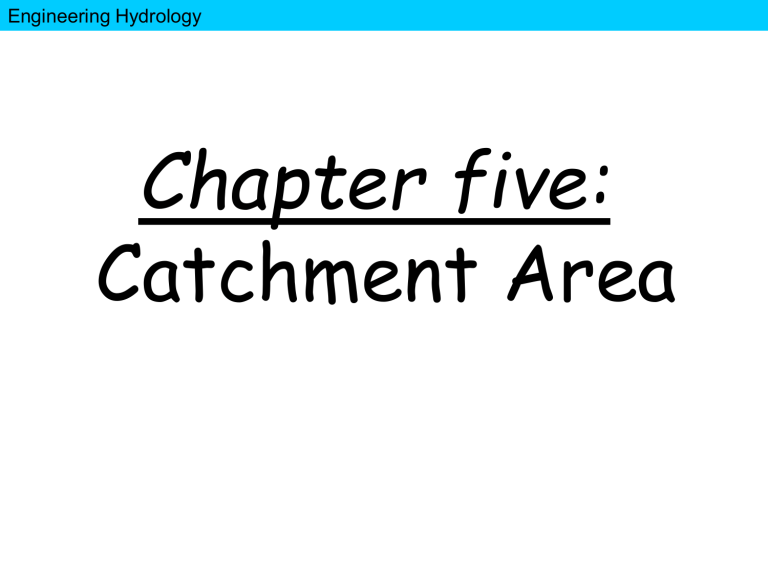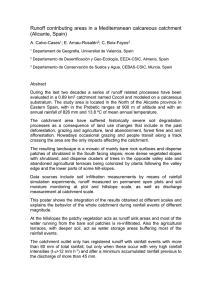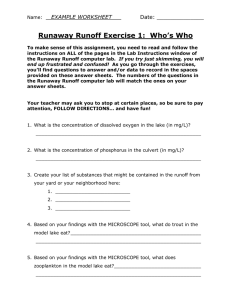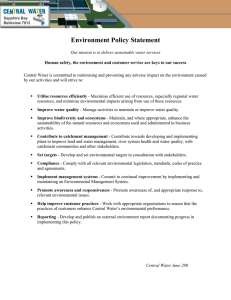
Engineering Hydrology Chapter five: Catchment Area Catchment Area The area of land draining into a stream or a water course at a given location is known as catchment area. Also called as drainage area or drainage basin or watershed (USA). Diagram showing two Catchments Catchment of River A at station M Estimating the Concentration Time of a Catchment Izzard’s Formula: For small plots having no defined flow channels from which run off occurs as laminar overland flow Where 111.b.L1o/ 3 To = minutes (K . p )2 / 3 b = a coefficien t = 0.000275 p + Cr So1/ 3 K = Runoff coefficient So = Slope of the surface Lo = Length of overland flow (m) p = Rainfall intensity (cm/hr) Cr = Retardance coefficient (Refer Table) To = Over land Flow Time / Inlet Time (min) These equations are applicable only when, p.Lo < 387. Types of Surface Value of Cr Smooth asphalt surface 0.007 Concrete pavement 0.012 Tar and gravel pavement 0.017 Closely clipped soil 0.046 Dense blue grass turf 0.060 Kirpich Formula: For design of hydraulic structures: L To = 0.885 H 3 o 0.385 Were, To = Overland flow time or Inlet Time (hour) Lo = Distance from the farthest (i.e., critical) point to outlet at hydraulic structure, such as culvert, etc (km) H = Total fall in level from the critical point to the outlet, such as culvert, etc(m) Lo and H can be found from the survey plan of the area, and To can be easily calculated. • For small drainage basin having flow channels in it • Tc = To + Tf • Where • Tf = channel flow time which exists anywhere in the channel • = length of the longest channel / average flow velocity in the channel at about bankful stage. Example: An area of 5 hectares in a single-family residence district has an average length of overland flow of 40 meters, average slope of the plots of 0.003, and the design rainfall is given by p = 64 To1 2 where p is in cm/hr and To is in minutes. Ignoring the intensity term in the retardance coefficient equation and using Cr = 0.05; find the time of concentration for the overland flow from this area. Assuming gutter flow time to add 10 min., find the peak rate of runoff to be expected. 111.b.L1o/ 3 To = minutes 2/3 (Kp ) b= C = 0.347 S r 1/ 3 o 111(0.347).(40)1 3 To = [0.3(64 To1 2 )]2 3 • Here, • Inlet time or overland flow time, To = 75 min • Gutter flow time, Tf = 10 min • Hence, • Total time of concentration, Tc = To + Tf = 75 + 10 = 85 min Therfore, p = 64 t = 64 85 = 6.92 cm/hr 0.5 12 C and, 1 1 Q = K . p .A = (0.3)(6.92 )(5 ) = 0.2883 cumec 36 36 max c Water Budget Equation From the continuity equation for water, i.e. Mass inflow - mass outflow = change in mass storage Water budget of a catchment for a time interval Δt is written as P–R–G–E-T=ΔS • • • • • • • Where P = precipitation, R = surface runoff, G = net ground water flow out of the catchment, E = evaporation, T = transpiration and Δ S = change in storage. • All terms in the equation may have the dimensions of volume or depth over the catchment area. EXAMPLE # 1 A lake had a water surface elevation of 103.2 m above datum at the beginning of certain month. In that month the lake received an average inflow of 6.0 m3/sec from surface runoff sources. In the same period the outflow from the lake had an average value of 6.5 m3/sec. Further, in that month, the lake received a rainfall of 145 mm and the evaporation from the lack surface was estimated as 6.10 cm. Write the water budget equation for the lake and calculate water surface elevation of the lake at the end of month. The average lake surface area can be taken as 5000 he. Assume that there is no contribution to or from the ground water storage. DATA: • WSE start = 103.2 m; • Surface Inflow = 6.0 m3/sec = 6.0 x 30 x 24 x 60 x 60 m3; • Surface Outflow = 6.5 m3/sec = 6.5 x 30 x 24 x 60 x 60 m3; • Area = 5000 he = 5000 x 104 m2; • Precipitation = 145 mm = 0.145 m = 0.145 x 5000 x 104 m3; • Evaporation = 6.10 cm = 6.10 x 10-2 m = 0.061 x 5000 x 104 m3; • Water budget equation = ? • WSEend = ? Solution: For the given lake, Water budget equation will be written as Inflow volume – Outflow volume = Change in storage (∆S) Inflow volume = Surface Inflow + Precipitation = (6.0 x 30 x 24 x 60 x 60) + (0.145 x 5000 x 104) = 22.802 x 106 m3 Outflow volume = Surface Outflow + Evaporation = (6.5 x 30 x 24 x 60 x 60 ) + (0.061 x 5000 x 104) = 19.898 x 106 m3 Therefore, ∆S = 22.802 x 106 - 19.898 x 106 = 2.904 x 106 m3 Change in elevation, ∆Z = ∆S/A = 2.904 x 106 / 5000 x 104 = 0.05808 m Hence, WSEend = WSEstart + ∆Z = 103.2 + 0.05808 = 103.25808 m Example # 2 A small catchment of area 150 he received a rainfall of 10.5 cm in 90 min duration due to a storm. At the outlet of the catchment, the stream draining the catchment was dry before the storm and experienced a runoff lasting for 10 hr with an average value of 2.0 m3/sec. The stream was again dry after the runoff event. What is the amount of water which was not available to runoff due to combined effect of infiltration, evaporation and transpiration? Also compute the ratio of runoff to precipitation. Data: Area = 150 he = 150 x 104 m2 Rainfall, P = 10.5 cm = 10.5/100 m = 0.105 m Storm duration, ∆tp = 90 min Runoff, R = 2.0 m3/sec = 2.0 x 10 x 60 x 60 m3 Runoff duration, ∆tr = 10 hr Solution: The general Water budget equation in time ∆t, ΔS = P – R – G – E - T (1) Amount of water not available for runoff, i.e. Losses, L = G + E + T Change in storage, ΔS = 0 (a) Hence Eq. (1) becomes, L = P – R Therefore, (2) L = (0.105 x 150 x 104) – (2.0 x 10 x 60 x 60) = 157,500 – 72,000 = 85,500 m3 (b) Runoff Coefficient = R/P = 72,000/157,500 = 0.457




